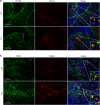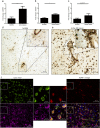Myelin alters the inflammatory phenotype of macrophages by activating PPARs
- PMID: 24252308
- PMCID: PMC3893408
- DOI: 10.1186/2051-5960-1-43
Myelin alters the inflammatory phenotype of macrophages by activating PPARs
Abstract
Background: Foamy macrophages, containing myelin degradation products, are abundantly found in active multiple sclerosis (MS) lesions. Recent studies have described an altered phenotype of macrophages after myelin internalization. However, mechanisms by which myelin affects the phenotype of macrophages and how this phenotype influences lesion progression remain unclear.
Results: We demonstrate that myelin as well as phosphatidylserine (PS), a phospholipid found in myelin, reduce nitric oxide production by macrophages through activation of peroxisome proliferator-activated receptor β/δ (PPARβ/δ). Furthermore, uptake of PS by macrophages, after intravenous injection of PS-containing liposomes (PSLs), suppresses the production of inflammatory mediators and ameliorates experimental autoimmune encephalomyelitis (EAE), an animal model of MS. The protective effect of PSLs in EAE animals is associated with a reduced immune cell infiltration into the central nervous system and decreased splenic cognate antigen specific proliferation. Interestingly, PPARβ/δ is activated in foamy macrophages in active MS lesions, indicating that myelin also activates PPARβ/δ in macrophages in the human brain.
Conclusion: Our data show that myelin modulates the phenotype of macrophages by PPAR activation, which may subsequently dampen MS lesion progression. Moreover, our results suggest that myelin-derived PS mediates PPARβ/δ activation in macrophages after myelin uptake. The immunoregulatory impact of naturally-occurring myelin lipids may hold promise for future MS therapeutics.
Figures






Similar articles
-
PPARβ/δ directs the therapeutic potential of mesenchymal stem cells in arthritis.Ann Rheum Dis. 2016 Dec;75(12):2166-2174. doi: 10.1136/annrheumdis-2015-208696. Epub 2016 Mar 8. Ann Rheum Dis. 2016. PMID: 26964143
-
Myelin-phagocytosing macrophages modulate autoreactive T cell proliferation.J Neuroinflammation. 2011 Jul 25;8:85. doi: 10.1186/1742-2094-8-85. J Neuroinflammation. 2011. PMID: 21781347 Free PMC article.
-
The transcriptional PPARβ/δ network in human macrophages defines a unique agonist-induced activation state.Nucleic Acids Res. 2015 May 26;43(10):5033-51. doi: 10.1093/nar/gkv331. Epub 2015 Apr 30. Nucleic Acids Res. 2015. PMID: 25934804 Free PMC article.
-
Autoimmune pathogenesis of multiple sclerosis: role of autoreactive T lymphocytes and new immunotherapeutic strategies.Crit Rev Immunol. 1997;17(1):33-75. doi: 10.1615/critrevimmunol.v17.i1.20. Crit Rev Immunol. 1997. PMID: 9034723 Review.
-
Peroxisome proliferator-activated receptor (PPAR)β/δ, a possible nexus of PPARα- and PPARγ-dependent molecular pathways in neurodegenerative diseases: Review and novel hypotheses.Neurochem Int. 2013 Oct;63(4):322-30. doi: 10.1016/j.neuint.2013.06.012. Epub 2013 Jun 25. Neurochem Int. 2013. PMID: 23811400 Review.
Cited by
-
Myelin and non-myelin debris contribute to foamy macrophage formation after spinal cord injury.Neurobiol Dis. 2022 Feb;163:105608. doi: 10.1016/j.nbd.2021.105608. Epub 2021 Dec 31. Neurobiol Dis. 2022. PMID: 34979258 Free PMC article.
-
MALDI imaging mass spectrometry: an emerging tool in neurology.Metab Brain Dis. 2022 Jan;37(1):105-121. doi: 10.1007/s11011-021-00797-2. Epub 2021 Aug 4. Metab Brain Dis. 2022. PMID: 34347208 Review.
-
Phloretin suppresses neuroinflammation by autophagy-mediated Nrf2 activation in macrophages.J Neuroinflammation. 2021 Jul 4;18(1):148. doi: 10.1186/s12974-021-02194-z. J Neuroinflammation. 2021. PMID: 34218792 Free PMC article.
-
The role of foam cells in spinal cord injury: challenges and opportunities for intervention.Front Immunol. 2024 Mar 13;15:1368203. doi: 10.3389/fimmu.2024.1368203. eCollection 2024. Front Immunol. 2024. PMID: 38545108 Free PMC article. Review.
-
Myelin Pathology in Alzheimer's Disease: Potential Therapeutic Opportunities.Aging Dis. 2024 Apr 1;15(2):698-713. doi: 10.14336/AD.2023.0628. Aging Dis. 2024. PMID: 37548935 Free PMC article. Review.
References
-
- Miller E, Mrowicka M, Zolynski K, Kedziora J. [Oxidative stress in multiple sclerosis] PolMerkur Lekarski. 2009;1:499–502. - PubMed
Publication types
MeSH terms
Substances
LinkOut - more resources
Full Text Sources
Other Literature Sources
Medical

